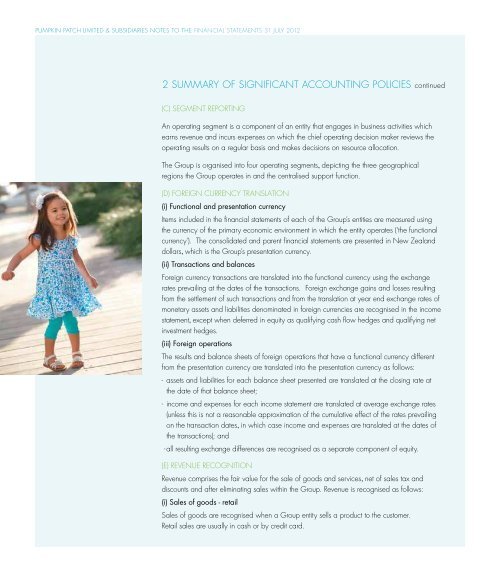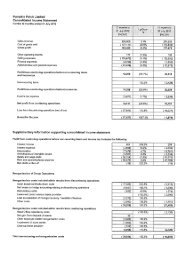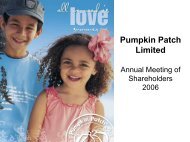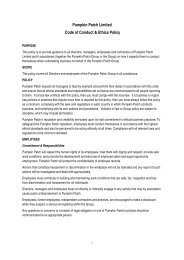annual report 2012 - Pumpkin Patch investor relations
annual report 2012 - Pumpkin Patch investor relations
annual report 2012 - Pumpkin Patch investor relations
- No tags were found...
You also want an ePaper? Increase the reach of your titles
YUMPU automatically turns print PDFs into web optimized ePapers that Google loves.
pumpkin patch limited & subsidiaries NOTES TO THE financial statements 31 july <strong>2012</strong>pumpkin patch limited & subsidiaries NOTES TO THE financial statements 31 july <strong>2012</strong>2 summary of significant accounting policies continued(c) Segment <strong>report</strong>ingAn operating segment is a component of an entity that engages in business activities whichearns revenue and incurs expenses on which the chief operating decision maker reviews theoperating results on a regular basis and makes decisions on resource allocation.The Group is organised into four operating segments, depicting the three geographicalregions the Group operates in and the centralised support function.(d) Foreign currency translation(i) Functional and presentation currencyItems included in the financial statements of each of the Group’s entities are measured usingthe currency of the primary economic environment in which the entity operates (‘the functionalcurrency’). The consolidated and parent financial statements are presented in New Zealanddollars, which is the Group’s presentation currency.(ii) Transactions and balancesForeign currency transactions are translated into the functional currency using the exchangerates prevailing at the dates of the transactions. Foreign exchange gains and losses resultingfrom the settlement of such transactions and from the translation at year end exchange rates ofmonetary assets and liabilities denominated in foreign currencies are recognised in the incomestatement, except when deferred in equity as qualifying cash flow hedges and qualifying netinvestment hedges.(iii) Foreign operationsThe results and balance sheets of foreign operations that have a functional currency differentfrom the presentation currency are translated into the presentation currency as follows:- assets and liabilities for each balance sheet presented are translated at the closing rate atthe date of that balance sheet;- income and expenses for each income statement are translated at average exchange rates(unless this is not a reasonable approximation of the cumulative effect of the rates prevailingon the transaction dates, in which case income and expenses are translated at the dates ofthe transactions); and- all resulting exchange differences are recognised as a separate component of equity.(e) Revenue recognitionRevenue comprises the fair value for the sale of goods and services, net of sales tax anddiscounts and after eliminating sales within the Group. Revenue is recognised as follows:(i) Sales of goods - retailSales of goods are recognised when a Group entity sells a product to the customer.Retail sales are usually in cash or by credit card.(ii) Sales of goods - wholesaleWholesale sales are recognised in accordance with the terms of sales when the title hastransferred and the benefits of ownership and risk pass to the customer. This is dependent oncustomer specific terms of trade.(iii) Interest incomeInterest income is recognised using the effective interest method.(iv) Dividend incomeDividend income is recognised when the right to receive payment is established.(f) Cost of goods soldCost of goods sold represent expenses associated with the design, purchase and all othercosts incurred in getting the inventory to the point of sale.(g) Income taxThe income tax expense or revenue for the period is the total of the current period’s taxableincome based on the income tax rate for each jurisdiction plus/minus any prior years’under/over provisions, plus/minus movements in the deferred tax balance except where themovement in deferred tax is attributable to a movement in reserves.Deferred tax assets and liabilities are recognised for temporary differences at the tax ratesexpected to apply when the assets are recovered or liabilities are settled, based on thosetax rates which are enacted or substantively enacted for each jurisdiction. No deferred taxasset or liability is recognised in relation to these temporary differences if they arose in atransaction, other than a business combination, that at the time of the transaction did not affecteither accounting profit or loss or taxable profit or loss.Deferred tax assets are recognised for deductible temporary differences and unused taxlosses only to the extent that is probable that future taxable amounts will be available to utilisethose temporary differences and losses.The income tax expense or revenue attributable to amounts recognised directly in equity arealso recognised directly in equity.(h) Goods and Services Tax (GST)The Income Statement has been prepared so that all components are stated exclusive of GST.All items in the balance sheet are stated net of GST, with the exception of receivables andpayables, which include GST invoiced.(i) Leases and Deferred Landlord ContributionsLeases in which a significant portion of the risks and rewards of ownership are retained bythe lessor are classified as operating leases. Payments made under operating leases arecharged to the Income Statement on a straight line basis over the period of the lease.51












